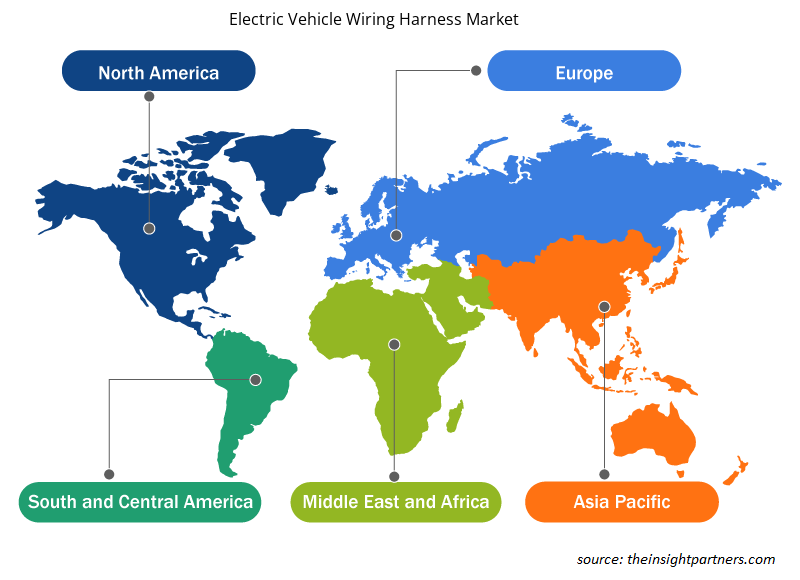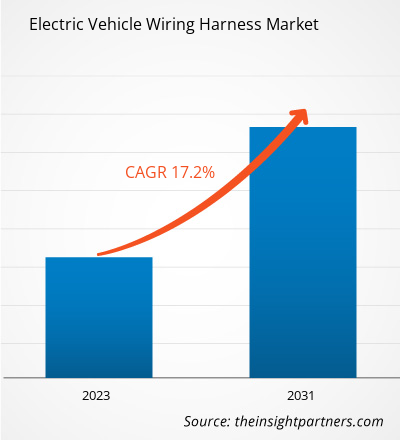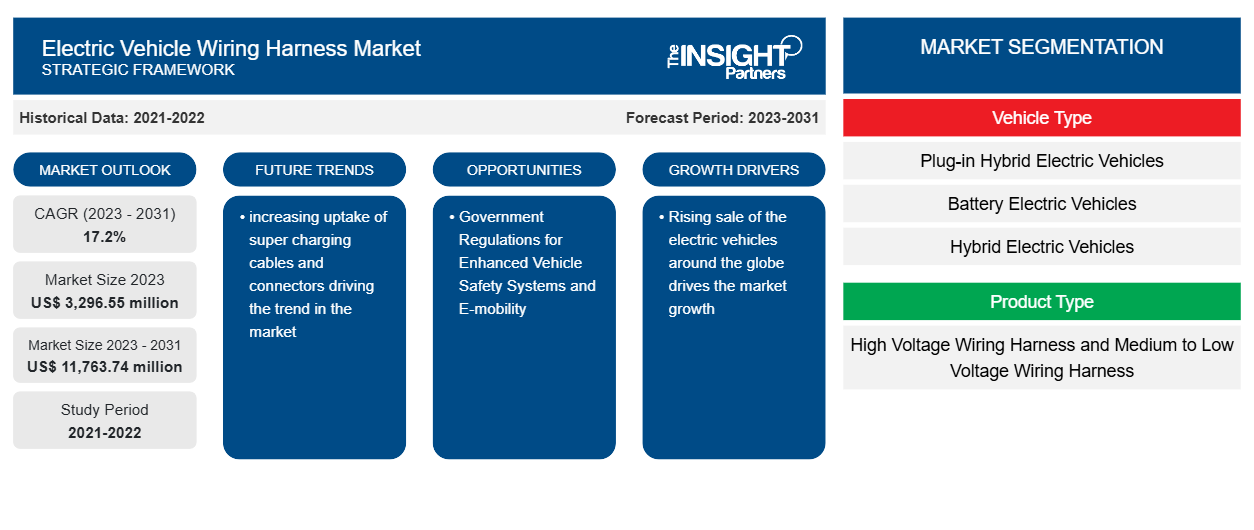Si prevede che la dimensione del mercato dei cablaggi per veicoli elettrici raggiungerà 11.763,74 milioni di dollari entro il 2031, rispetto ai 3.296,55 milioni di dollari del 2023. Si prevede che il mercato registrerà un CAGR del 17,2% nel periodo 2023-2031. La crescente diffusione di cavi e connettori di super ricarica sta guidando la tendenza del mercato.
Analisi del mercato dei cablaggi per veicoli elettrici
I produttori nel mercato globale dei cablaggi per veicoli elettrici eseguono vari processi, come la progettazione, l'assemblaggio e la trasformazione delle materie prime in prodotti finiti. Coroplast Fritz Müller GmbH & Co. KG; Cypress Industries; Fujikura Ltd.; e Furukawa Electric Co., Ltd.; tra gli altri, sono alcuni dei principali attori nel mercato dei cablaggi per veicoli elettrici. Le aziende offrono un'ampia gamma di prodotti per veicoli elettrici ibridi plug-in, veicoli elettrici a batteria, veicoli elettrici ibridi e veicoli elettrici a celle a combustibile OEM . Gli utenti finali hanno un gran numero di clienti, dagli acquirenti di veicoli per uso personale agli operatori di flotte. Si prevede che la crescente attenzione al miglioramento del risparmio di carburante dei veicoli, l'aumento della produzione di veicoli elettrici e l'elevata domanda di cablaggi leggeri presenteranno opportunità significative per le aziende che pianificano di entrare in questo mercato.
Panoramica del mercato dei cablaggi per veicoli elettrici
L'ecosistema del mercato dei cablaggi per veicoli elettrici comprende i seguenti stakeholder: fornitori di materie prime, produttori di cablaggi, OEM e utenti finali. I principali attori occupano posizioni significative nei vari nodi dell'ecosistema del mercato dei cablaggi per veicoli elettrici. I fornitori di materie prime forniscono componenti come alluminio e rame, tra gli altri, per costruire il cablaggio. I componenti di un cablaggio per veicoli elettrici includono connettori, terminali, serrature, fili, cavi e rivestimenti esterni.
Personalizza questo report in base alle tue esigenze
Riceverai la personalizzazione gratuita di qualsiasi report, comprese parti di questo report, o analisi a livello nazionale, pacchetto dati Excel, oltre a usufruire di grandi offerte e sconti per start-up e università
-
Scopri le principali tendenze di mercato in questo rapporto.Questo campione GRATUITO includerà analisi di dati che spaziano dalle tendenze di mercato alle stime e alle previsioni.
Driver e opportunità del mercato dei cablaggi per veicoli elettrici
Crescente domanda di imbracature leggere
I progressi tecnologici e la crescente produzione di veicoli elettrici ( EV ) portano alla crescente domanda di cablaggi leggeri per ottenere una riduzione del peso e un migliore imballaggio del veicolo. Si prevede che l'integrazione di funzionalità avanzate in autovetture autonome e veicoli commerciali leggeri contribuirà ulteriormente alla crescita del mercato durante il periodo di previsione.
I principali attori del mercato si stanno concentrando sullo sviluppo di materiali conduttori, come CuAg (rame/argento), CuSn (rame/stagno) e CuMg (rame/magnesio), per l'ottimizzazione dell'attuale progettazione del sistema di cablaggio. I conduttori in rame sono i principali nel settore grazie alla loro eccellente conduttività elettrica e sicurezza, e ai vantaggi per la leggerezza. La crescente R&S per ridurre il contenuto di metallo aiuta a ottenere un peso ridotto e ad aumentare l'efficienza complessiva del carburante del veicolo. Oltre a questo, anche le soluzioni di cablaggio leggere ed ecologiche , come i sistemi di cablaggio ad alta tensione per veicoli ibridi e plug-in, stanno guadagnando rapidamente popolarità.
Regolamenti governativi per sistemi di sicurezza avanzata dei veicoli e mobilità elettrica
In Nord America, si prevede che iniziative del governo, politiche federali e programmi per vari settori guideranno il mercato dei cablaggi per veicoli elettrici. Stati Uniti, Canada e Messico hanno firmato l'accordo commerciale NAFTA. L'accordo commerciale aiuta le case automobilistiche con l'aumento del numero di stabilimenti di produzione e una migliore catena di fornitura di ricambi auto. La crescente domanda di veicoli ibridi ed elettrici e la crescente elettrificazione dei veicoli sono i fattori principali che guidano il mercato globale dei cablaggi per veicoli elettrici. Le severe norme sulle emissioni per i veicoli stanno costringendo gli OEM a produrre veicoli ibridi ed elettrici per ridurre le emissioni di gas nocivi. Il Dipartimento dei trasporti degli Stati Uniti ha stabilito gli standard Corporate Average Fuel Economy (CAFE) per i veicoli. Gli standard del Codice nazionale di sicurezza canadese (NSC) regolano i veicoli commerciali , i conducenti e gli autotrasportatori in Canada. L'NSC è un codice di standard minimi di prestazione per il funzionamento sicuro dei veicoli commerciali.
Analisi della segmentazione del rapporto di mercato del cablaggio dei veicoli elettrici
I segmenti chiave che hanno contribuito alla derivazione dell'analisi di mercato dei cablaggi per veicoli elettrici sono il tipo di veicolo, il tipo di prodotto, il tipo di materiale e l'area geografica.
- In base al tipo di veicolo, il mercato è suddiviso in veicoli elettrici ibridi plug-in (PHEV), veicoli elettrici a batteria (BEV), veicoli elettrici ibridi (HEV) e veicoli elettrici a batteria a celle a combustibile (FCBEV). Tra questi, i veicoli elettrici a batteria (BEV) hanno la quota maggiore nel 2023, questo è dovuto all'aumento delle vendite di veicoli elettrici in tutto il mondo.
- A seconda del tipo di prodotto, il mercato è diviso in cablaggio ad alta tensione e cablaggio a media e bassa tensione. Tra questi, il cablaggio a media e bassa tensione ha una quota maggiore nel 2023.
- In base al tipo di materiale, il mercato è suddiviso in filo rivestito in rame, filo in lega di alluminio, fibra ottica in vetro, fibra ottica in plastica e altri. Tra questi, il filo in lega di alluminio sta crescendo a ritmo rapido durante il periodo di previsione.
Analisi della quota di mercato del cablaggio dei veicoli elettrici per area geografica
L'ambito geografico del rapporto di mercato sui cablaggi per veicoli elettrici è suddiviso principalmente in cinque regioni: Nord America, Asia Pacifico, Europa, Medio Oriente e Africa, e Sud e Centro America.
L'Asia Pacifica detiene la quota maggiore nel mercato dei cablaggi per veicoli elettrici a causa dell'aumento delle vendite di veicoli elettrici in questa regione. L'aumento della domanda dei consumatori per funzionalità costose nelle automobili sta incoraggiando i produttori a investire in soluzioni tecnologiche di fascia alta. L'industria automobilistica è stata la prima vittima economica del COVID-19 in Cina con la chiusura di importanti siti di produzione e stabilimenti di produzione di automobili. Il mercato automobilistico nella regione Asia Pacifica ha continuato a riprendersi fortemente nel 2021. Gli esperti del settore prevedono che i margini delle case automobilistiche miglioreranno nell'anno fiscale 2022. La ripresa del mercato sta incoraggiando la crescita delle soluzioni di cablaggio per veicoli elettrici. Nella maggior parte dei paesi, i sussidi sono uno strumento fondamentale per mantenere la politica sui veicoli elettrici a causa dei costi più elevati dei veicoli. Il governo giapponese ha predisposto 77,1 milioni di dollari di sussidi per i veicoli elettrici a gennaio 2021 per aumentare le vendite di BEV. Diverse nuove società di venture capital stanno emergendo nel mercato dei veicoli elettrici in Cina, Giappone e Corea del Sud, il che si stima possa fornire opportunità di crescita redditizie per il mercato dei cablaggi per veicoli elettrici.
Approfondimenti regionali sul mercato dei cablaggi per veicoli elettrici
Le tendenze regionali e i fattori che influenzano il mercato dei cablaggi per veicoli elettrici durante il periodo di previsione sono stati ampiamente spiegati dagli analisti di Insight Partners. Questa sezione discute anche i segmenti e la geografia del mercato dei cablaggi per veicoli elettrici in Nord America, Europa, Asia Pacifico, Medio Oriente e Africa e Sud e Centro America.

- Ottieni i dati specifici regionali per il mercato dei cablaggi dei veicoli elettrici
Ambito del rapporto sul mercato del cablaggio dei veicoli elettrici
| Attributo del report | Dettagli |
|---|---|
| Dimensioni del mercato nel 2023 | 3.296,55 milioni di dollari USA |
| Dimensioni del mercato entro il 2031 | 11.763,74 milioni di dollari USA |
| CAGR globale (2023-2031) | 17,2% |
| Dati storici | 2021-2022 |
| Periodo di previsione | 2023-2031 |
| Segmenti coperti |
Per tipo di veicolo
|
| Regioni e Paesi coperti |
America del Nord
|
| Leader di mercato e profili aziendali chiave |
|
Densità degli attori del mercato: comprendere il suo impatto sulle dinamiche aziendali
Il mercato del cablaggio elettrico per veicoli sta crescendo rapidamente, spinto dalla crescente domanda degli utenti finali dovuta a fattori quali l'evoluzione delle preferenze dei consumatori, i progressi tecnologici e una maggiore consapevolezza dei vantaggi del prodotto. Con l'aumento della domanda, le aziende stanno ampliando le loro offerte, innovando per soddisfare le esigenze dei consumatori e capitalizzando sulle tendenze emergenti, il che alimenta ulteriormente la crescita del mercato.
La densità degli operatori di mercato si riferisce alla distribuzione di aziende o società che operano in un particolare mercato o settore. Indica quanti concorrenti (operatori di mercato) sono presenti in un dato spazio di mercato in relazione alle sue dimensioni o al valore di mercato totale.
Le principali aziende che operano nel mercato dei cablaggi per veicoli elettrici sono:
- Coroplast Fritz Müller Gmbh & Co. Kg
- Azienda
- Società elettrica Furukawa Ltd.
- Azienda: Motherson Sumi Systems Ltd.
- Nexans Autoelectric GmbH
Disclaimer : le aziende elencate sopra non sono classificate secondo un ordine particolare.

- Ottieni la panoramica dei principali attori del mercato dei cablaggi per veicoli elettrici
Notizie e sviluppi recenti sul mercato dei cablaggi per veicoli elettrici
Il mercato dei cablaggi per veicoli elettrici viene valutato raccogliendo dati qualitativi e quantitativi dopo la ricerca primaria e secondaria, che include importanti pubblicazioni aziendali, dati di associazioni e database. Di seguito sono elencati alcuni degli sviluppi nel mercato dei cablaggi per veicoli elettrici:
- Delphi annuncia il lancio della sua nuova gamma di pastiglie freno BEV dedicate alle esigenze specifiche delle applicazioni BEV. Sulla base di confronti dettagliati, questa gamma è tra le più complete al mondo oggi e copre i modelli più popolari nell'aftermarket indipendente. I veicoli includono Nissan Leaf e Tesla Model S/Model 3, oltre ai modelli più recenti come BMW i4/iX, Mercedes EQC/EQEE/QS e Porsche Taycan/Cross Turismo. Con l'introduzione di 52 numeri di parte che coprono 2,7 milioni di veicoli in funzione in Europa, Delphi offre un'importante opportunità di servizio per le officine. (Fonte: sito Web aziendale, febbraio 2024)
- Allied Nippon ha lanciato EV+, una gamma di pastiglie freno completamente nuova e completa per veicoli elettrici. (Fonte: comunicato stampa, giugno 2023)
Copertura e risultati del rapporto sul mercato del cablaggio dei veicoli elettrici
Il rapporto "Dimensioni e previsioni del mercato dei cablaggi per veicoli elettrici (2021-2031)" fornisce un'analisi dettagliata del mercato che copre le seguenti aree:
- Dimensioni e previsioni del mercato dei cablaggi per veicoli elettrici a livello globale, regionale e nazionale per tutti i principali segmenti di mercato coperti dall'ambito
- Tendenze del mercato dei cablaggi per veicoli elettrici e dinamiche di mercato come conducenti, sistemi di ritenuta e opportunità chiave
- Analisi PEST e SWOT dettagliate
- Analisi del mercato dei cablaggi per veicoli elettrici che copre le principali tendenze del mercato, il quadro globale e regionale, i principali attori, le normative e i recenti sviluppi del mercato
- Analisi del panorama industriale e della concorrenza che copre la concentrazione del mercato, l'analisi della mappa di calore, i principali attori e gli sviluppi recenti per il mercato dei cablaggi per veicoli elettrici
- Profili aziendali dettagliati
- Analisi storica (2 anni), anno base, previsione (7 anni) con CAGR
- Analisi PEST e SWOT
- Valore/volume delle dimensioni del mercato - Globale, Regionale, Nazionale
- Industria e panorama competitivo
- Set di dati Excel
Report recenti
Rapporti correlati
Testimonianze
Motivo dell'acquisto
- Processo decisionale informato
- Comprensione delle dinamiche di mercato
- Analisi competitiva
- Analisi dei clienti
- Previsioni di mercato
- Mitigazione del rischio
- Pianificazione strategica
- Giustificazione degli investimenti
- Identificazione dei mercati emergenti
- Miglioramento delle strategie di marketing
- Aumento dell'efficienza operativa
- Allineamento alle tendenze normative























 Ottieni un campione gratuito per - Mercato dei cablaggi per veicoli elettrici
Ottieni un campione gratuito per - Mercato dei cablaggi per veicoli elettrici